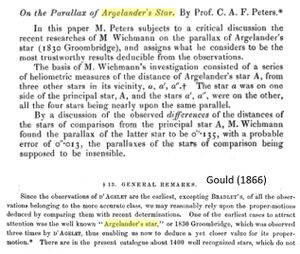Argelander’s Star: Difference between revisions
Ericmamajek (talk | contribs) (→Etymology and History: image added) |
Ericmamajek (talk | contribs) No edit summary |
||
| Line 26: | Line 26: | ||
[[Category:Constellation]] |
[[Category:Constellation]] |
||
[[Category:Eurasia]] |
[[Category:Eurasia]] |
||
[[Category: |
[[Category:European]] |
||
[[Category:Modern]] |
[[Category:Modern]] |
||
Revision as of 12:10, 5 July 2024
modern name for HD 103095 = HR 4550
Etymology and History
The star was first catalogued as Groombridge 1830 (Groombridge, 1838, “A Catalogue of Circumpolar Stars”; Stephen Groombridge 1755-1832), but F.W.A. Argelander (1799-1875) first reported as the star with highest known proper motion in 1842 (at 7”/yr it is still 3rd highest proper motion star behind Barnard’s Star and Kapteyn’s Star).
The name appeared in Peters (1853) “On the Parallax of Argelander’s Star”. Remarkably he was critiquing measurement of a parallax by M. Wichmann (135+-13 mas), which is only 2sigma from the Gaia EDR3 value: 109.0296+-0.0197 mas!
It is the only star brighter than 7th mag among the fastest 6 stars (next on list is naked eye pair 61 Cygni). Argelander is best known for the 19th century Bonner Durchmusterung (BD) catalog of 324,198 stars. Note that Groombridge observed the star 5 times and reported a mean position and magnitude, but there are no notes of anything special about it. Name used sporadically. Gould 1866, an 1875 Nature article, Jim Kaler’s site, von Humboldt 1901, Lehti+2010, Butkevich+2014, Lintott 2019
Not yet in SIMBAD. Wikipedia article.
Mythology
IAU Star Name
WGSN discussed the name in 2022 but decided (for the time being) not to name stars after people.





